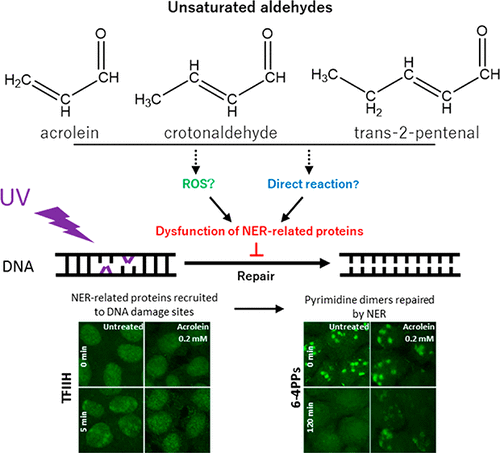当前位置:
X-MOL 学术
›
Chem. Res. Toxicol.
›
论文详情
Our official English website, www.x-mol.net, welcomes your feedback! (Note: you will need to create a separate account there.)
α,β-Unsaturated Aldehyde-Induced Delays in Nucleotide Excision Repair and the Contribution of Reactive Oxygen Species
Chemical Research in Toxicology ( IF 4.1 ) Pub Date : 2018-01-17 00:00:00 , DOI: 10.1021/acs.chemrestox.7b00304 Guang Yang 1 , Yuko Ibuki 1
Chemical Research in Toxicology ( IF 4.1 ) Pub Date : 2018-01-17 00:00:00 , DOI: 10.1021/acs.chemrestox.7b00304 Guang Yang 1 , Yuko Ibuki 1
Affiliation

|
Aldehydes are widespread environmental and industrial compounds to which humans are frequently exposed. Despite their significant health risk, the mechanisms underlying aldehyde toxicity are poorly understand. We recently demonstrated that cigarette sidestream smoke (CSS) inhibited nucleotide excision repair (NER), and this was attributed to aldehydes in CSS. In the present study, we examined the influence of saturated and unsaturated aldehydes on NER. The human keratinocyte cell line, HaCaT, was treated with aldehydes and then exposed to UVB. Saturated aldehydes did not show toxicity, whereas α,β-unsaturated aldehydes caused cell death, which was markedly enhanced by UV exposure. The speed of NER was examined by the detection of pyrimidine (6-4) pyrimidone photoproducts (6-4PPs) using ELISA and local UV irradiation assay. The repair of 6-4PPs was markedly reduced by α,β-unsaturated aldehydes, but not by saturated aldehydes, and this was attributed to a delay in the recruitment of repair proteins (TFIIH and XPG) to DNA damage sites. Reactive oxygen species (ROS) were produced after a treatment with α,β-unsaturated aldehydes, and hydrogen peroxide (H2O2) inhibited the repair of 6-4PPs, similar to α,β-unsaturated aldehydes. H2O2 inhibited the accumulation of XPA and XPG at DNA damage sites, whereas TFIIH showed the same recruitment with or without H2O2. These results suggest that an exposure to α,β-unsaturated aldehydes, not saturated aldehydes inhibits NER by delaying the recruitment of NER proteins to DNA damage sites, and α,β-unsaturated aldehyde-induced ROS production may partially play a role in this process.
中文翻译:

α,β-不饱和醛诱导的核苷酸切除修复延迟和活性氧的贡献
醛是人类经常接触的广泛的环境和工业化合物。尽管它们具有重大的健康风险,但对醛毒性的机理尚不甚了解。我们最近证明,香烟支流烟(CSS)抑制了核苷酸切除修复(NER),这归因于CSS中的醛类。在本研究中,我们研究了饱和和不饱和醛对NER的影响。用醛处理人角质形成细胞系HaCaT,然后将其暴露于UVB中。饱和醛未显示毒性,而α,β-不饱和醛可导致细胞死亡,而紫外线暴露可显着增强细胞死亡。通过使用ELISA和局部UV辐射测定法检测嘧啶(6-4)嘧啶酮光产物(6-4PPs)来检查NER的速度。6,4PPs的修复被α,β-不饱和醛明显减少,但不被饱和醛减少,这归因于修复蛋白(TFIIH和XPG)募集到DNA损伤位点的延迟。用α,β-不饱和醛和过氧化氢(H2 O 2)抑制6-4PPs的修复,类似于α,β-不饱和醛。H 2 O 2抑制XPA和XPG在DNA损伤部位的积累,而TFIIH在有或没有H 2 O 2的情况下均表现出相同的募集。这些结果表明,暴露于α,β-不饱和醛而不是饱和醛会延迟NER蛋白向DNA损伤位点的募集而抑制NER,并且α,β-不饱和醛诱导的ROS产生可能在此过程中部分起作用。
更新日期:2018-01-17
中文翻译:

α,β-不饱和醛诱导的核苷酸切除修复延迟和活性氧的贡献
醛是人类经常接触的广泛的环境和工业化合物。尽管它们具有重大的健康风险,但对醛毒性的机理尚不甚了解。我们最近证明,香烟支流烟(CSS)抑制了核苷酸切除修复(NER),这归因于CSS中的醛类。在本研究中,我们研究了饱和和不饱和醛对NER的影响。用醛处理人角质形成细胞系HaCaT,然后将其暴露于UVB中。饱和醛未显示毒性,而α,β-不饱和醛可导致细胞死亡,而紫外线暴露可显着增强细胞死亡。通过使用ELISA和局部UV辐射测定法检测嘧啶(6-4)嘧啶酮光产物(6-4PPs)来检查NER的速度。6,4PPs的修复被α,β-不饱和醛明显减少,但不被饱和醛减少,这归因于修复蛋白(TFIIH和XPG)募集到DNA损伤位点的延迟。用α,β-不饱和醛和过氧化氢(H2 O 2)抑制6-4PPs的修复,类似于α,β-不饱和醛。H 2 O 2抑制XPA和XPG在DNA损伤部位的积累,而TFIIH在有或没有H 2 O 2的情况下均表现出相同的募集。这些结果表明,暴露于α,β-不饱和醛而不是饱和醛会延迟NER蛋白向DNA损伤位点的募集而抑制NER,并且α,β-不饱和醛诱导的ROS产生可能在此过程中部分起作用。



























 京公网安备 11010802027423号
京公网安备 11010802027423号